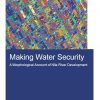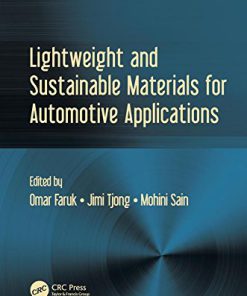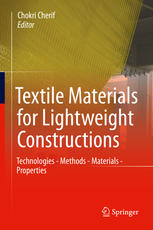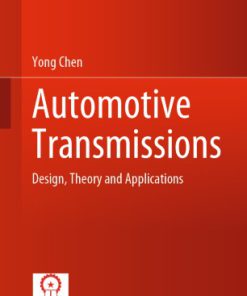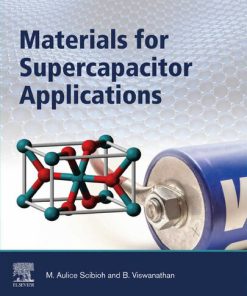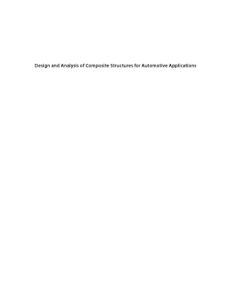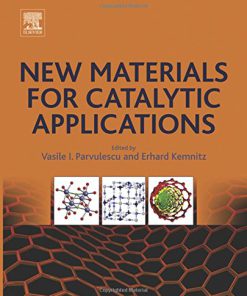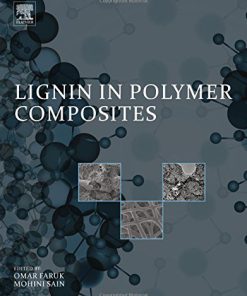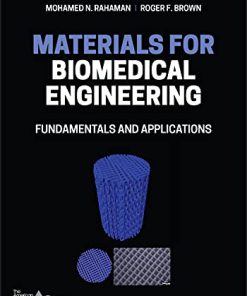Lightweight and sustainable materials for automotive applications 1st Edition by Omar Faruk, Mohini Sain, Jimi Tjong 1498756875 9781498756877
$50.00 Original price was: $50.00.$25.00Current price is: $25.00.
Lightweight and sustainable materials for automotive applications 1st Edition by Omar Faruk, Mohini Sain, Jimi Tjong – Ebook PDF Instant Download/DeliveryISBN: 1498756875, 9781498756877
Full download Lightweight and sustainable materials for automotive applications 1st Edition after payment.
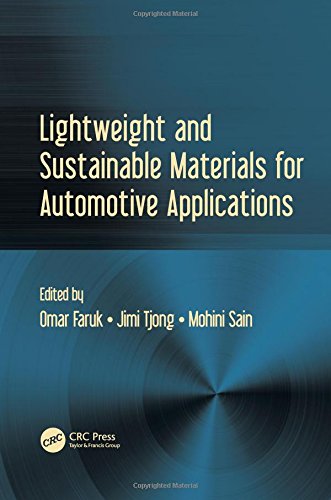
Product details:
ISBN-10 : 1498756875
ISBN-13 : 9781498756877
Author: Omar Faruk, Mohini Sain, Jimi Tjong
Automotive manufacturers are required to decrease CO2 emissions and increase fuel economy while assuring driver comfort and safety. In recent years, there has been rapid development in the application of lightweight and sustainable materials in the automotive industry to help meet these criteria. This book provides critical reviews and the latest research results of various lightweight and sustainable materials in automotive applications. It discusses current applications and future trends of lightweight materials in the automotive area. While there are a few books published mainly focusing on automotive applications of metallic lightweight materials, to date there is no available book focusing on a broad spectrum of lightweight materials, including metal, plastic, composites, bio-fiber, bio-polymer, carbon fiber, glass fiber, nanomaterials, rubber materials, and foaming materials, as this work does. The book also includes case studies of commercial lightweight automotive parts from sustainable lightweight materials, providing an invaluable resource to those involved in this in-demand research and commercialization area.
Lightweight and sustainable materials for automotive applications 1st Table of contents:
Chapter 1 Natural Fiber Reinforced Thermoplastic Composites
1.1 Introduction
1.1.1 Polypropylene Composites with Natural Fibers
1.1.2 Polyethylene Composites with Natural Fibers
1.1.3 Other Thermoplastic Composites with Natural Fibers
1.1.4 Natural Fiber–Thermoplastic Composites in Automotive
1.2 Conclusions
References
Chapter 2 Bio-Fiber Thermoset Composites
2.1 Introduction
2.2 Bio-Fiber Materials for Composites
2.2.1 Introduction and Classification
2.2.2 Structure, Composition, and Extraction
2.2.3 Pros and Cons of Bio-Fibers
2.2.4 Reinforcements for Composites
2.3 Thermosetting Resins for Bio-Fiber Composites
2.3.1 Epoxy Resin
2.3.2 Polyester Resin
2.3.3 Vinylester Resin
2.3.4 Other Thermoset Resin Systems
2.4 Limitations of Bio-Fiber Thermoset Composites
2.4.1 Inconsistency
2.4.2 Moisture
2.4.3 Fiber–Matrix Interface
2.5 Fiber Modification Suiting Bio-Fiber Thermoset Composites
2.5.1 Physical Treatments
2.5.2 Chemical Treatments
2.6 Composite Manufacturing Technologies
2.6.1 Hand Lamination
2.6.2 Resin Transfer Molding (RTM)
2.6.3 Compression Molding
2.6.4 Pultrusion
2.7 Properties of Bio-Fiber Thermoset Composites
2.7.1 Mechanical
2.7.2 Energy Absorption
2.7.3 Fatigue
2.7.4 Abrasion
2.7.5 Thermal
2.8 Applications of Bio-Fiber Thermoset Composites
2.8.1 Bio-Fiber Composites in Automotive
2.9 Conclusion and Future Trends in Bio-Fiber Thermoset Composites Manufacturing and Usage
Acknowledgments
References
Chapter 3 Wood Fiber Reinforced Thermoplastic and Thermosets Composites
3.1 Introduction
3.2 Definitions and Scope
3.3 Pulping Processes to Obtain Wood and Cellulose Fibers
3.4 Wood Fiber and Wood Flour-Based Thermoplastic Composites
3.4.1 Composition, Processing, and Applications
3.4.2 Mechanical and Physical Properties
3.4.3 Effects of Additional Reinforcement by Glass, Carbon, and Nano-Sized Fibers
3.4.4 Durability
3.4.5 Fire Retardancy
3.4.6 Emissions and Odor
3.5 Wood Fiber and Wood Flour-Based Thermoset Composites
3.5.1 Composition and Properties
3.5.2 Processing
3.6 Recycling and Life-Cycle Assessment (LCA) of Composites
3.7 Automotive Applications
3.7.1 Overview
3.7.2 Thermoplastic Composites
3.7.2.1 Hot-Pressing Followed by Compression-Molding
3.7.2.2 Injection-Molding
3.7.2.3 Sheet Extrusion and Thermoforming
3.7.3 Thermoset Composites
3.7.3.1 Fibrowood
3.8 Outlook
References
Chapter 4 Bio-Based Thermoplastic and Thermosets Polymer
4.1 Wording
4.1.1 Degradable Petrochemical-Based Bioplastics
4.1.2 Degradable (Primarily) Bio-Based Bioplastics
4.1.3 Nondegradable Bio-Based Bioplastics
4.1.4 Old and New Economy Bioplastics
4.2 Process Technologies
4.3 Materials
4.3.1 Bio-Based Polyesters
4.3.1.1 Bio-Based Polyethylene Terephthalate (Bio-PET)
4.3.1.2 Polytrimethylene Terephthalate (PTT)
4.3.1.3 Polylactide (PLA)
4.3.2 Bio-Based Polyethylene (Bio-PE)
4.3.3 Bio-Based Polyamides (Bio-PA)
4.3.4 Bio-Based Polyurethanes (Bio-PUR)
4.3.5 Bio-Based Thermosetting Resins
4.3.5.1 Bio-Based Epoxy Resins
4.3.5.2 Bio-Based Unsaturated Polyester Resins
4.4 Properties
4.5 Biocomposites
4.6 Conclusions
References
Chapter 5 Bio-Based EPDM Rubber and Sustainable EPDM Compounding
5.1 General Introduction
5.2 Keltan EPDM Rubber
5.3 Keltan Eco Bio-Based EPDM Rubber4,5
5.3.1 Introduction
5.3.2 Experimental
5.3.2.1 Polymer Evaluation
5.3.2.2 Compound Evaluation
5.3.3 Results and Discussion
5.4 Sustainable EPDM Compounding8
5.4.1 Introduction
5.4.2 Experimental
5.4.3 Results and Discussion
5.4.3.1 Bio-Based Oils
5.4.3.2 Sustainable Fillers
5.5 Conclusions
Acknowledgments
References
Chapter 6 Carbon Fiber Composite Materials
6.1 Introduction
6.2 Properties of Carbon Fiber
6.3 Fiber Production and Structure
6.3.1 Heat Treatment and Phase Inversion
6.4 Surface Treatment of Carbon Fibers
6.4.1 Chemical Method
6.4.2 Physical Method
6.5 Processing of Composites
6.6 Performance of Composites
6.6.1 Thermal Properties
6.6.2 Mechanical Properties
6.6.3 Morphology
6.6.4 Different PA Composites: A Comparison
6.6.4.1 Morphology
6.6.4.2 Flexural Properties
6.6.4.3 Tensile Properties
6.6.4.4 Impact Properties
6.6.4.5 Heat Deflection Temperature
6.6.4.6 Heat Aging of Carbon Fiber Composites
6.6.4.7 Flexural Properties
6.6.4.8 Tensile Properties
6.7 Recent Application and Future Trends
6.8 Conclusions
References
Chapter 7 Glass Fiber Composite Materials
7.1 Introduction
7.2 History of Glass Fiber and GFRP
7.3 Classification and Properties of Glass Fibers
7.4 Preparation of GFRP Composites
7.4.1 Silicone Rubber Mold
7.4.2 Hand Lay-Up Techniques
7.4.3 Hot Press Technique
7.4.4 Filler Mixed Molding
7.4.5 Compression Molding Technique
7.5 Mechanical Properties of the GFRP
7.6 Vibration Characteristics of GFRP
7.7 Thermal Characteristics of GFRP
7.8 Tribological Behavior of GFRP
7.9 Environmental Behaviors of GFRP Composites
7.10 Application of GFRP Composites
7.11 Conclusion
References
Chapter 8 Lightweight Nanocomposite Materials
8.1 Introduction
8.2 Quest for a Lightweight Vehicle
8.3 Lightweight Nanocomposites
8.3.1 Vehicle Lightweighting Gains
8.3.2 Polymeric Nanocomposites
8.3.3 Elastomeric Nanocomposites
8.3.4 Electro-Conductive Nanocomposites
8.3.5 Green Nanocomposites
8.4 Nanofillers for Nanocomposite Applications
8.4.1 Structure of Clay Minerals: General Outline
8.4.2 Intercalation by Self-Assembled Organic Compounds
8.4.2.1 Surface-Engineered Clays: Layered Double Hydroxides (LDH) Modified with Fatty Acids
8.5 Green Nanocomposites Modified with Surface-Engineered Nanofillers
8.5.1 Examples of Green Nanocomposites and Their Properties
8.5.1.1 Input Materials
8.5.1.2 Fabrication of Green Nanocomposites
8.5.1.3 Characterization
8.5.2 Results and Discussion
8.5.2.1 Morphology/XRD/TEM/SEM
8.5.2.2 Mechanical Properties
8.5.3 Conclusions Regarding Properties of Green Nanocomposites
References
Chapter 9 Tribology of Aluminum and Aluminum Matrix Composite Materials for Automotive Components
9.1 Introduction
9.2 Applications of Aluminum ALLOYS in Vehicles
9.2.1 Powertrain Applications
9.2.2 Chassis Applications
9.2.3 Body Structure
9.3 Aluminum Matrix Composites
9.4 Sliding Wear Applications OF Aluminum-Matrix Composites
9.5 Wear Regimes and Transitions in Aluminum Alloys
9.5.1 Mild and Severe Wear in Aluminum Alloys
9.6 Sliding Wear of Aluminum-Silicon Alloys
9.6.1 Micro-Mechanisms of Ultra-Mild Wear (UMW)
9.7 Sliding Wear of Aluminum Matrix Composites Reinforced by Carbide and Oxide Particles
9.7.1 Mild and Ultra-Mild Wear
9.7.2 Wear Transitions and Severe Wear
9.8 Fracture of Second Phase Particles
9.9 Role of Transfer Layers on the Sliding Wear Behavior
9.10 Load-Bearing Capacity of Tribolayer
9.11 Conclusions
Acknowledgment
References
Chapter 10 Magnesium and Its Alloys
10.1 Introduction to Magnesium
10.1.1 Properties of Pure Magnesium
10.1.1.1 Atomic Properties and Crystal Structure
10.1.1.2 Physical Properties
10.1.1.3 Mechanical Properties
10.1.2 Extraction
10.1.3 Utilization
10.1.4 Advantages and Disadvantages of Magnesium [8]10.2 Alloying of Magnesium
10.2.1 Alloying Elements and Designations
10.2.2 The Effects of Alloying Elements
10.2.3 Types of Magnesium Alloys
10.2.3.1 Cast Magnesium
10.2.3.2 Wrought Magnesium
10.2.4 Properties of Magnesium Alloys
10.3 Processing of Magnesium Alloys
10.3.1 Processing of Cast Magnesium Alloys
10.3.1.1 Sand Casting
10.3.1.2 Stir Casting
10.3.1.3 Die Casting
10.3.1.4 Squeeze Casting
10.3.1.5 Semi-Solid Metal (SSM) Casting
10.3.1.6 Melt Deposition Technique
10.3.2 Processing of Wrought Alloys
10.3.2.1 Extrusion Processes
10.3.2.2 Forging Processes
10.3.3 Sheet Production and Forming Processes
10.3.3.1 Sheet Production Processes
10.3.3.2 Sheet Forming Processes
10.3.4 Welding and Joining Techniques
10.3.4.1 Welding Processes
10.3.4.2 Joining Processes
10.4 Automotive Applications of Magnesium Alloys
10.4.1 Historical Development
10.4.2 Magnesium as a Material in Automobiles
10.4.2.1 Lightweight
10.4.2.2 Cost
10.4.2.3 Mechanical Properties
10.4.2.4 Recyclability
10.4.3 Current and Potential Applications of Magnesium Alloys
10.4.3.1 Interior
10.4.3.2 Body
10.4.3.3 Chassis
10.4.3.4 Power Train
10.4.4 Technical Problems and Challenges for Use of Magnesium Alloys in the Automotive Industry
10.5 Conclusions
Acknowledgments
References
Chapter 11 Thermoplastics FoamsAn Automotive Perspective
11.1 Introduction
11.2 Structure-Property Correlation
11.2.1 Stiffness
11.2.1.1 Rigid Foams
11.2.1.2 Semi-Rigid Foams
11.2.1.3 Flexible Foams
11.2.2 Cell Type
11.2.2.1 Closed Cell Foams
11.2.2.2 Open Cell Foams
11.2.2.3 Cell Diameter
11.2.3 Structural Foams
11.2.4 Structure of Strut
11.2.4.1 Solid Strut Foams
11.2.4.2 Hollow Strut Foams
11.2.5 Blowing Agent
11.2.5.1 Chemical Foaming
11.2.5.2 Physical Foaming
11.2.6 Properties of Foams
11.2.6.1 Thermal Conductivity
11.2.6.2 Mechanical Properties
11.2.6.3 Response to Compression
11.2.6.4 Response to Tension
11.2.6.5 Melt Strength
11.2.6.6 Fire Retardancy
11.2.6.7 Dielectric Constant (k)
11.3 Processing Routes
11.3.1 Foam Extrusion
11.3.1.1 Free-Foaming Extrusion
11.3.1.2 Controlled Foam Extrusion
11.3.1.3 Tandem Extrusion
11.3.1.4 Low-Pressure Nitrogen Process
11.3.1.5 MuCellTM
11.3.2 Injection Molding Foam
11.3.2.1 Low Pressure Injection Foam Molding
11.3.2.2 High Pressure Injection Foam Molding
11.3.2.3 Gas-Assisted Injection Molding
11.3.2.4 Co-Injection Mold Foaming
11.3.3 Microcellular Foaming
11.3.3.1 MuCellTM
11.3.3.2 ErgocellTM
11.3.4 Bead Foaming
11.3.4.1 Bead Production
11.3.4.2 Steam Chest Molding
11.4 Automotive Application of Thermoplastic Foams
11.5 Outlook
11.6 Summary
References
Chapter 12 Lightweight Thermoset Foams in Automotive Applications
12.1 Introduction
12.2 Thermoset Foams
12.2.1 Polyurethane Foams
12.2.2 Epoxy Foams
12.3 Applications of Thermoset Foams in Automotives
12.3.1 Cushioning Applications
12.3.2 Energy Absorptive Applications
12.3.3 Spoilers
12.4 Material Selection for Automotive Applications
12.4.1 Mechanical Properties of Thermoset Foams
12.4.1.1 Compressive Modulus
12.4.1.2 Energy Absorption
12.4.1.3 Strain Rate Dependence
12.4.2 Vibration Attenuation in Thermoset Foams
12.4.3 Flame Resistance in Thermoset Foams
12.4.4 Other Properties
12.5 Trends
12.6 Conclusion
References
Chapter 13 Life Cycle Assessment of Lightweight Materials for Automotive Applications
13.1 Introduction
13.2 Bio-Based Carbon Storage
13.3 Land Use Change Problems in the Production of the Natural Fibers
13.4 Recycling and End of Life
13.5 Life Cycle Assessment
13.6 Data Quality
13.7 Life Cycle Assessment of Auto Parts
13.8 Excluded Process and Cut-Off Rules
13.9 Sensitivity Analysis
13.10 Mass Induce Fuel Change
References
Chapter 14 Case Studies—Sustainable and Lightweight Automotive Parts via Injection Molding
14.1 Overview of Lightweight and Sustainable Materials
14.2 Material Selection Criteria
14.2.1 Material Properties versus Product Requirements
14.3 Case Studies
14.3.1 Material Selection
14.3.2 Case Study 1: Beauty Shield
14.3.2.1 Material Selection
14.3.2.2 Process Validation
14.3.3 Case Study 2: Door Cladding—Exterior
14.3.3.1 Material Selection
14.3.3.2 Process Validation
14.3.4 Case Study 3: Battery Tray
14.3.4.1 Material Selection
14.3.4.2 Process Validation
14.3.5 Case Study 4: Cam Cover
14.3.5.1 Material Selection
14.3.5.2 Process Validation
14.3.6 Additional Case Studies
14.3.7 Design and Development Challenges
14.3.7.1 Material Selection
14.3.7.2 Cost
14.4 Future Outlook
People also search for Lightweight and sustainable materials for automotive applications 1st:
lightweight and sustainable materials for automotive applications
lightweight and sustainable materials for aerospace applications
lightweight and sustainable materials a global scenario
lightweight and sustainable composite materials
list of sustainable materials
Tags: Lightweight, sustainable materials, automotive applications, Omar Faruk, Mohini Sain, Jimi Tjong
You may also like…
Engineering - Automotive
Automotive Transmissions: Design, Theory and Applications Yong Chen
Technique - Automation
Design and Analysis of Composite Structures for Automotive Applications 1st Edition Vladimir Kobelev
Engineering
Lignin in Polymer Composites 1st Edition by Omar Faruk, Mohini Sain 0323355650 9780323355650



